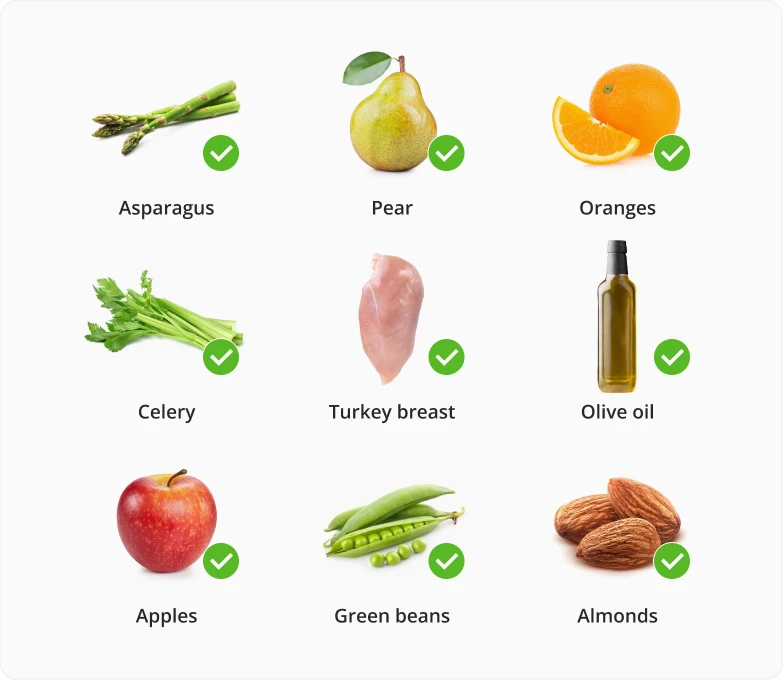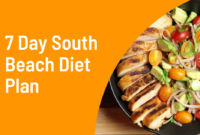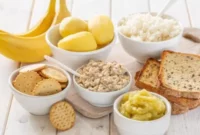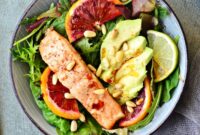South Beach Diet snacks offer a delicious and effective way to manage weight and improve overall health. This guide delves into the principles of the South Beach Diet, focusing specifically on snack choices that align with its phases and restrictions. We’ll explore approved snack options, provide sample snack plans, and offer recipe ideas to make healthy snacking enjoyable and sustainable. Understanding the nuances of appropriate snack selection is crucial for success on this diet, and this guide aims to provide the necessary information and tools to navigate this aspect effectively.
We will cover everything from creating a weekly snack plan that adheres to the diet’s guidelines to understanding the differences between South Beach Diet snacks and those permitted on other popular weight-loss plans. We’ll also equip you with practical tips on grocery shopping and deciphering food labels to ensure your snack choices remain aligned with the diet’s principles. This comprehensive approach will empower you to make informed decisions about snacking while following the South Beach Diet.
Understanding the South Beach Diet
The South Beach Diet is a popular weight-loss plan that emphasizes healthy eating habits and sustainable weight management, rather than relying on restrictive calorie counting or eliminating entire food groups. It focuses on controlling blood sugar levels through strategic carbohydrate choices, promoting gradual and consistent weight loss. Unlike many fad diets, it aims to teach you how to make long-term dietary changes that support overall health.
The South Beach Diet differentiates itself through its phased approach and focus on specific types of carbohydrates. The diet prioritizes lean protein, healthy fats, and non-starchy vegetables while limiting refined carbohydrates and unhealthy fats. This approach helps to stabilize blood sugar, reduce cravings, and promote a feeling of satiety.
Phases of the South Beach Diet
The South Beach Diet is structured into three phases, each with its own set of dietary guidelines and restrictions. Successfully completing each phase helps to gradually reintroduce foods and establish lasting healthy eating habits.
- Phase 1: The Induction Phase (Days 1-14): This initial phase is the most restrictive. It eliminates sugary drinks, processed foods, and most high-glycemic carbohydrates like white bread, pastries, and sugary cereals. Allowed foods include lean protein (fish, poultry, beans), non-starchy vegetables (broccoli, spinach, peppers), healthy fats (olive oil, avocados), and limited amounts of whole grains like oatmeal. The goal is to rapidly reduce blood sugar levels and jumpstart weight loss. This phase helps to reset the body’s metabolism and curb cravings for sugary foods.
- Phase 2: The Weight-Loss Phase (Weeks 2-Ongoing): Once the initial weight loss is achieved, Phase 2 allows for a gradual reintroduction of healthy carbohydrates, including whole grains, fruits, and some legumes. Portion sizes remain important. The emphasis continues on lean protein, healthy fats, and non-starchy vegetables. This phase allows for more variety and helps maintain weight loss. The duration of this phase depends on individual progress and weight loss goals.
- Phase 3: The Lifetime Maintenance Phase: This is the final phase, designed to be a long-term lifestyle change. It involves further broadening the range of acceptable foods, including more carbohydrates and occasional treats, while maintaining a healthy balance of macronutrients. The focus shifts to mindful eating and maintaining a healthy weight long-term. This phase emphasizes continued healthy eating habits to prevent weight regain.
Dietary Restrictions and Allowances
The specific restrictions and allowances vary significantly across the three phases. Understanding these differences is crucial for successful implementation of the diet. For example, while sugary drinks and processed foods are strictly limited in Phase 1, they are allowed in moderation in Phase 3. Similarly, certain fruits and whole grains are introduced gradually.
It is important to consult a healthcare professional or registered dietitian before starting any new diet, especially if you have underlying health conditions.
Snacking on the South Beach Diet
The South Beach Diet emphasizes healthy fats and lean proteins while limiting carbohydrates, particularly refined sugars. Successful weight management on this diet often hinges on smart snacking choices that keep hunger at bay and prevent blood sugar spikes. Choosing the right snacks can help maintain energy levels and prevent cravings for less-healthy options.
Snacking on the South Beach Diet requires careful consideration of glycemic index (GI) and glycemic load (GL). Foods with a low GI and GL are digested slowly, preventing rapid increases in blood sugar. This is crucial for maintaining stable energy levels and preventing weight gain. Focusing on nutrient-dense snacks ensures you’re getting essential vitamins and minerals while staying within the diet’s guidelines.
Approved South Beach Diet Snacks
The South Beach Diet encourages snacks that are high in protein and healthy fats, and low in carbohydrates. These snacks help keep you feeling full and satisfied between meals, reducing the likelihood of overeating later.
- Hard-boiled eggs: A great source of protein and essential nutrients.
- A small handful of nuts (almonds, walnuts, pecans): Rich in healthy fats and fiber.
- Greek yogurt (plain, unsweetened): High in protein and probiotics.
- Cheese (cheddar, mozzarella, etc.): Provides protein and calcium.
- Celery sticks with peanut butter (natural, no added sugar): Combines fiber and healthy fats.
- A small avocado: Rich in monounsaturated fats and fiber.
- A piece of fruit (berries are generally preferred due to their lower glycemic index): Provides natural sweetness and antioxidants.
- String cheese: Convenient and protein-packed.
Examples of Healthy, Low-Glycemic Snacks
These examples highlight the balance of protein, healthy fats, and low-glycemic carbohydrates that are key to successful South Beach snacking. Remember to control portion sizes to manage calorie intake.
- 1/4 cup of almonds and a small apple (choose low-glycemic varieties like Granny Smith): The almonds provide healthy fats and protein, while the apple offers some natural sweetness and fiber.
- 2 hard-boiled eggs and a small handful of cherry tomatoes: A protein-rich snack that also includes some vitamins and antioxidants.
- 1/2 cup plain Greek yogurt with a sprinkle of cinnamon: Cinnamon can help regulate blood sugar and adds flavor without added sugar.
- A small serving of cottage cheese with a few slices of cucumber: Provides protein and fiber.
Sample One-Week Snack Plan
This sample plan provides a variety of options, demonstrating the flexibility within the South Beach Diet guidelines. Remember to adjust portion sizes based on your individual caloric needs and activity level. This is a sample and individual needs may vary.
| Day | Morning Snack | Afternoon Snack | Evening Snack |
|---|---|---|---|
| Monday | Hard-boiled egg | Small handful of almonds | 1/2 cup plain Greek yogurt |
| Tuesday | String cheese | Celery sticks with peanut butter | Small avocado |
| Wednesday | 1/4 cup cottage cheese | Small handful of walnuts | Handful of berries |
| Thursday | Hard-boiled egg | Small apple slices with a tablespoon of almond butter | 1/2 cup plain Greek yogurt with cinnamon |
| Friday | String cheese | Small handful of pecans | Small avocado with a sprinkle of salt and pepper |
| Saturday | 1/4 cup cottage cheese | Celery sticks with hummus (check ingredients for added sugars) | Handful of berries |
| Sunday | Hard-boiled egg | Small handful of almonds | 1/2 cup plain Greek yogurt |
Recipe Ideas for South Beach Diet Snacks
The South Beach Diet emphasizes whole, unprocessed foods and limits refined carbohydrates and sugars. Choosing the right snacks is crucial for maintaining energy levels and preventing cravings while adhering to the diet’s principles. These recipes offer delicious and nutritious options that fit seamlessly into the South Beach Diet plan.
South Beach Almond Butter Celery Sticks
This snack combines the healthy fats and protein of almond butter with the fiber-rich crunch of celery. It’s a satisfying and easy-to-prepare option that keeps you feeling full and energized.
- Ingredients: 2 stalks celery, 2 tablespoons almond butter (unsweetened), 1/4 teaspoon cinnamon (optional).
- Instructions: Wash and cut celery into 4-inch sticks. Spread almond butter evenly onto each celery stick. Sprinkle with cinnamon, if desired.
- Nutritional Information (per serving, approximately): Calories: 150-180; Fat: 12-15g; Protein: 4-6g; Carbohydrates: 7-10g; Fiber: 2-3g.
- Benefits: Provides healthy fats, fiber, and protein, promoting satiety and stabilizing blood sugar levels. The combination helps curb cravings and supports sustained energy throughout the day, in line with the South Beach Diet’s focus on balanced macronutrients.
Hard-Boiled Eggs with Avocado Slices
This protein-packed snack is perfect for those needing a boost of energy and essential nutrients. The combination of eggs and avocado offers a good balance of protein, healthy fats, and essential vitamins.
- Ingredients: 2 large eggs, 1/4 avocado, salt and pepper to taste.
- Instructions: Hard-boil the eggs. Once cooled, peel and slice the eggs. Slice the avocado and arrange it alongside the egg slices.
- Nutritional Information (per serving, approximately): Calories: 250-300; Fat: 20-25g; Protein: 12-15g; Carbohydrates: 5-7g; Fiber: 5-7g.
- Benefits: Provides high-quality protein and healthy monounsaturated fats, promoting satiety and supporting healthy cholesterol levels. This snack aligns perfectly with the South Beach Diet’s emphasis on lean protein and healthy fats, helping manage hunger and maintain energy without excessive carbohydrates.
Cucumber and Cottage Cheese Bites
This refreshing snack is low in calories and high in protein, making it an ideal choice for those watching their weight while adhering to the South Beach Diet’s guidelines.
- Ingredients: 1 cucumber, 1/2 cup low-fat cottage cheese, 1 tablespoon chopped fresh dill (optional).
- Instructions: Wash and slice the cucumber into 1/2-inch thick rounds. Top each cucumber slice with a spoonful of cottage cheese. Sprinkle with dill, if desired.
- Nutritional Information (per serving, approximately): Calories: 80-100; Fat: 3-5g; Protein: 10-12g; Carbohydrates: 5-7g; Fiber: 1-2g.
- Benefits: Offers a good source of protein and hydration, promoting satiety without a significant calorie intake. The low carbohydrate content aligns with the South Beach Diet’s focus on controlling blood sugar levels and preventing spikes in insulin, supporting weight management and overall health.
Comparing South Beach Diet Snacks to Other Diets
The South Beach Diet, with its emphasis on low-glycemic index foods, offers a distinct approach to snacking compared to other popular diets. Understanding these differences is crucial for choosing the best dietary strategy for individual needs and preferences. This comparison will highlight the key distinctions in macronutrient composition and potential health benefits between South Beach Diet snacks and those allowed on ketogenic and Mediterranean diets.
A primary difference lies in the macronutrient profiles. The South Beach Diet encourages a balance of carbohydrates, proteins, and fats, prioritizing complex carbohydrates and healthy fats over simple sugars. Ketogenic diets, conversely, drastically reduce carbohydrate intake, favoring high fat and moderate protein consumption. The Mediterranean diet, while also emphasizing healthy fats and proteins, incorporates a wider range of fruits, vegetables, and whole grains than the South Beach Diet.
Macronutrient Composition of Snacks Across Different Diets
The following table illustrates the typical macronutrient distribution in snacks permitted under each diet. Note that these are general guidelines and individual snack choices will vary.
| Diet | Carbohydrates (%) | Protein (%) | Fat (%) | Example Snack |
|---|---|---|---|---|
| South Beach Diet | 30-40 | 20-30 | 30-40 | A small handful of almonds with a piece of fruit like berries |
| Ketogenic Diet | 5-10 | 20-30 | 60-75 | Cheese and a handful of macadamia nuts |
| Mediterranean Diet | 40-50 | 20-25 | 25-35 | A small bowl of Greek yogurt with a sprinkle of nuts and a drizzle of olive oil |
Health Implications and Potential Advantages and Disadvantages
Each dietary approach offers unique advantages and disadvantages regarding overall health. The South Beach Diet’s balanced approach may promote sustained weight loss and improved blood sugar control, while the ketogenic diet’s high fat content may lead to rapid weight loss initially but could potentially pose risks for some individuals, particularly those with kidney or liver issues. The Mediterranean diet, often cited for its heart-health benefits, emphasizes a wide array of nutrient-rich foods, potentially reducing the risk of chronic diseases.
The best dietary approach is highly individualized and depends on factors such as health status, preferences, and lifestyle. Consulting a registered dietitian or healthcare professional is recommended before making significant dietary changes.
Shopping for South Beach Diet Snacks
Successfully navigating the grocery store while adhering to the South Beach Diet requires a strategic approach. Understanding which foods to prioritize and how to decipher food labels is key to making healthy and affordable choices. This section will provide a sample shopping list, explain how to select budget-friendly options, and guide you through the process of interpreting food labels.
Creating a shopping list before heading to the grocery store is crucial for staying on track with the South Beach Diet. A well-planned list minimizes impulse purchases and ensures you have the necessary ingredients for healthy snacks throughout the week. This also helps control spending by preventing unnecessary purchases.
Weekly South Beach Diet Snack Shopping List
This sample shopping list provides a variety of options for a week’s worth of snacks, emphasizing whole, unprocessed foods. Remember to adjust quantities based on your individual needs and preferences.
- 1 pound almonds
- 1 cup walnuts
- 1 large avocado
- 1 pint cherry tomatoes
- 1 cucumber
- 1 bell pepper (any color)
- 1 container (16 oz) plain Greek yogurt (0% or 2% fat)
- 1 package (8 oz) string cheese (part-skim)
- 1 can tuna in water (packed in water, not oil)
- Hard-boiled eggs (prepare 6-8 at home)
- A variety of berries (strawberries, blueberries, raspberries)
Selecting Healthy and Affordable Options
Shopping smart on the South Beach Diet doesn’t have to break the bank. By focusing on affordable, nutrient-rich options and employing strategic shopping techniques, you can maintain a healthy diet without excessive spending.
Prioritize in-season produce, which tends to be cheaper and fresher. Buy in bulk when appropriate for items like nuts and seeds, but ensure proper storage to maintain freshness. Consider store brands; often, they offer comparable quality at a lower price than name brands. Planning your meals and snacks beforehand prevents impulse buys and food waste.
Reading Food Labels for South Beach Diet Compliance
Understanding food labels is paramount to making informed choices while following the South Beach Diet. Pay close attention to the following aspects of food labels:
First, check the serving size. Many products list nutritional information per serving, so understanding the serving size helps you accurately calculate your daily intake. Second, examine the carbohydrate content. The South Beach Diet emphasizes limiting refined carbohydrates, so choose foods with lower net carbohydrate counts (total carbohydrates minus fiber). Third, focus on the fat content. The diet does not prohibit healthy fats, but it’s important to be mindful of saturated and trans fats. Finally, examine the sodium content, opting for lower-sodium options to help manage blood pressure.
Always look for foods with minimal added sugars and unhealthy fats.
Visual Guide to South Beach Diet Snacks
A picture is worth a thousand words, and when it comes to understanding the appeal of South Beach Diet snacks, a visual representation can be incredibly helpful. This section will paint a vivid picture of three different snacks, highlighting their textures, colors, and aromas to help you imagine the delicious and satisfying experience. We’ll also delve into the step-by-step preparation of one of these snacks, guiding you through the process with sensory details.
South Beach Diet Snack Descriptions
Three distinctly different South Beach Diet-friendly snacks offer a variety of tastes and textures, proving that healthy eating doesn’t have to be boring. Consider these examples:
First, imagine a vibrant bowl of sliced cucumber and bell peppers, a medley of emerald green, sunny yellow, and deep crimson. The crisp, refreshing crunch of the cucumber contrasts beautifully with the slightly firmer texture of the peppers. The aroma is subtly sweet and fresh, almost grassy, hinting at the natural sweetness of the vegetables.
Next, picture a handful of almonds, their rich brown shells contrasting with the creamy off-white of the kernels. The texture is satisfyingly firm, with a slight give as you bite into them. The aroma is nutty and slightly oily, a warm, earthy fragrance that speaks of wholesome goodness.
Finally, envision a small serving of Greek yogurt topped with a sprinkle of chia seeds. The yogurt is a creamy white, its texture smooth and cool. The tiny black chia seeds add a pleasant textural contrast, providing a slightly gritty counterpoint to the yogurt’s smoothness. The aroma is subtly tangy and refreshing, a clean, dairy-like scent.
Preparing a Cucumber and Avocado Snack
This simple snack is both visually appealing and incredibly easy to prepare. The combination of creamy avocado and refreshing cucumber provides a delightful contrast in textures and flavors.
First, select a ripe avocado. Its skin should yield slightly to gentle pressure. The aroma should be subtly creamy and slightly nutty. Carefully cut the avocado in half lengthwise, remove the pit, and scoop out the flesh with a spoon. The creamy texture and pale green color are instantly apparent.
Next, wash a cucumber thoroughly. Its skin should be smooth and firm, its color a vibrant, deep green. Slice the cucumber into thin rounds using a sharp knife. The sound of the knife slicing through the cucumber is crisp and satisfying. The aroma is clean and refreshing, subtly grassy.
Gently mash the avocado flesh with a fork, creating a smooth, creamy paste. The pale green color intensifies as you mash. The creamy texture and mild, slightly nutty aroma are even more pronounced.
Arrange the cucumber slices on a plate and spoon the mashed avocado over them. The contrast between the vibrant green of the cucumber and the paler green of the avocado is visually appealing. The combined aroma is a delightful blend of creamy avocado and fresh cucumber. A sprinkle of salt and freshly ground black pepper enhances the flavors.
Addressing Potential Challenges
The South Beach Diet, while effective for many, presents certain challenges that can hinder adherence and ultimately affect results. Understanding these common hurdles and developing strategies to overcome them is crucial for long-term success. This section will address some prevalent difficulties and offer practical solutions.
Successfully navigating the South Beach Diet’s snack guidelines often requires careful planning and a proactive approach to managing cravings and potential setbacks. Many find the initial adjustment period the most difficult, requiring significant changes to established eating habits and snack choices. However, with the right mindset and strategies, these challenges can be effectively addressed.
Difficulty Finding Approved Snacks
Finding convenient and palatable snacks that align with the South Beach Diet’s guidelines can be a significant challenge. Many pre-packaged snacks contain high levels of sugar, unhealthy fats, or refined carbohydrates, making it difficult to find suitable options on the go. This can lead to frustration and potential lapses in the diet.
Managing Hunger and Cravings
The initial stages of the South Beach Diet, particularly Phase 1, can involve increased feelings of hunger, especially if individuals are used to consuming high-carbohydrate snacks. These cravings can be intense and lead to deviations from the diet plan. Effectively managing hunger and cravings is essential for long-term adherence.
Maintaining Adherence During Social Situations
Social gatherings often involve food that doesn’t conform to the South Beach Diet’s restrictions. Navigating parties, restaurant meals, or other social events where unhealthy snack options are prevalent requires careful planning and potentially assertive communication about dietary needs. This can be socially challenging for some individuals.
Adapting the Diet to Specific Dietary Needs
Individuals with specific dietary needs, such as allergies, intolerances, or vegetarian/vegan preferences, may find it particularly challenging to find appropriate South Beach Diet-compliant snacks. Ensuring the diet meets individual nutritional requirements while adhering to its core principles requires careful consideration and potentially creative substitutions. For example, a person with a nut allergy needs to carefully check all labels to avoid accidental consumption of nut-based products. A vegan following the diet would need to focus on plant-based protein sources and carefully choose snacks without animal products or hidden ingredients.
Strategies for Overcoming Challenges
Developing a structured approach to snacking is vital. Planning meals and snacks in advance can help prevent impulsive, unhealthy choices. Keeping a supply of approved snacks readily available at home, work, and in the car can help manage hunger and avoid resorting to less healthy alternatives. Furthermore, incorporating regular physical activity can help manage cravings and improve overall well-being, indirectly supporting dietary adherence.
Alternative Snack Options for Specific Needs
For individuals with nut allergies, sunflower seed butter or tahini can replace nut butters. Those avoiding dairy can opt for coconut yogurt or almond milk-based options. Vegetarians and vegans can find suitable protein sources in edamame, lentils, or tofu-based snacks. Always check food labels carefully to ensure that snacks meet individual dietary requirements and align with the South Beach Diet’s guidelines. For example, a person with a gluten intolerance needs to ensure that all their snacks are certified gluten-free.
Summary
Successfully navigating the South Beach Diet requires careful consideration of snack choices. This guide has provided a framework for understanding appropriate snacks, offering recipes, sample plans, and practical advice on grocery shopping and label reading. By understanding the principles of the diet and making informed snack selections, individuals can enhance their chances of achieving their weight management goals and reaping the overall health benefits associated with this dietary approach. Remember that consistency and mindful choices are key to long-term success.




